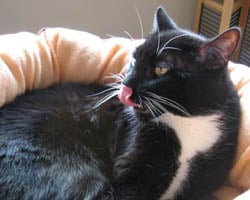
As many cat owners already know, our feline friends can be extremely finicky. Switching them to a raw diet may be difficult or it may be easy-it all depends on your cat. And for cats that do not easily make the transition, be prepared to demonstrate plenty of patience and persistence.
Cats are obligate carnivores, meaning they absolutely need raw meat as part of a complete diet. Reviewing the characteristics of a cat will reinforce this point. Cats have:
- Strong predatory instincts, such as stalking, chasing, and pouncing
- Excellent eyesight
- Acute hearing
- A keen sense of smell
- Soft paw pads for silently stalking prey
- Sharp claws for traction while hunting and catching prey
- Sharp teeth that come together to slice like scissors for gnawing, ripping, and tearing
- Jaws that open and close in a vertical plane only, rather than moving horizontally
- Strong stomach acids for neutralizing potentially harmful bacteria on raw meat
- Short digestive tract which makes for rapid digestive transit time, minimizing the opportunity for potentially harmful bacterial colonization
How to Switch Kitty to a Raw Diet
If your cat is on dry food, stop free feeding. Offer the same amount of food every day, but split it into three meals and remove each meal after 20 minutes. This will give a bit of an edge to the cat’s appetite, and will help reduce your cat’s addiction to grain-based carbohydrates.
Another approach is to first switch the cat to a wet canned food, which is closer to the texture of raw food. If the cat is already used to eating canned food, this is the time to eliminate the dry altogether.
Each cat is different and each will react differently to being switched to a raw diet. Do not force your cat or leave your cat without food for more than 24 hours. Cats are very susceptible to a serious and potentially fatal liver disease called Hepatic Lipidosis. When the cat’s body is starved, it begins to use its stored fat reserves. This fat is then sent to the liver to be transformed into energy, but the liver is unable to metabolize the extra fat and the liver cells become swollen with fatty deposits, damaging the organ. This results in nausea and vomiting, making it difficult for cats to eat enough to survive.
It is important that your cat eats enough every day. The switch may have to follow a staggered approach in which you continue to feed the cat the food it already eats readily while adding a few bribe foods to get the cat to eat more raw food.
Bribe food ideas include:
- a drizzling of juice from a can of water-packed tuna
- a smear of canned cat food
- a bit of grated Parmesan cheese
- some smashed canned sardines, anchovies or herring
- a sprinkling of crushed kibble
- some meat, bone and/or giblet broth, used like a marinade
- a favorite treat you know your kitty loves
Most importantly, let the cat make the transition at her own pace, and don’t give up! Contrary to what your kitty may think, you are smarter than they are.
More on caring for cats from Naturally Savvy:
Examing Your Pet's Teeth to Catch Problems Early
Toxic Treats: Foods That Can Harm Your Pets
Caring for Your Pet in the Summer Months




